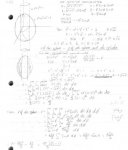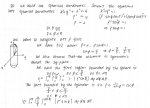You are using an out of date browser. It may not display this or other websites correctly.
You should upgrade or use an alternative browser.
You should upgrade or use an alternative browser.
How to find the volume?
- Thread starter helenli89
- Start date
I'm not so sure you seem to get a very different equation with the Spherical coordinates compare to the solution given by my professor who also uses the spherical coordinates. I don't think that with the same coordinates there could be 2 complete different equation to solve the same volumn. Otherwise we wouldn't have to memerize the volumn for cylinders when we were in high school.
I think My volumn for the sphere and the cylinder is incomplete and the 4pi/3 should be -4pi/3 (I made a misstake). I have found an example my prof did in class (attached). I only did the volumns for the part that's bounded by the shperes on top of the cylinder so I need to find the volumn for the part that's bounded by the cylinder but if I found the the hight of the cylinder then this become very easy. So I did the following. since x^2 +y^2 =1 -> x^2 +y^2 +z^2=2 becomes 1+z^2=2 then z^2=1 then half of the volum has hight 1 then the positive half of the cylinder have pi*r^2*1 = pi then the volumn that's bounded by the cylinder is 2pi the the whole thing is 2*pi-4pi/3. Then use the volumn of the sphere - this whole volumn which still doesn't equal to the correct answer.
Can anyone try this?
I think My volumn for the sphere and the cylinder is incomplete and the 4pi/3 should be -4pi/3 (I made a misstake). I have found an example my prof did in class (attached). I only did the volumns for the part that's bounded by the shperes on top of the cylinder so I need to find the volumn for the part that's bounded by the cylinder but if I found the the hight of the cylinder then this become very easy. So I did the following. since x^2 +y^2 =1 -> x^2 +y^2 +z^2=2 becomes 1+z^2=2 then z^2=1 then half of the volum has hight 1 then the positive half of the cylinder have pi*r^2*1 = pi then the volumn that's bounded by the cylinder is 2pi the the whole thing is 2*pi-4pi/3. Then use the volumn of the sphere - this whole volumn which still doesn't equal to the correct answer.
Can anyone try this?
Attachments
BigGlenntheHeavy
Senior Member
- Joined
- Mar 8, 2009
- Messages
- 1,577
\(\displaystyle What!! \ V \ = \ \frac{\pi h^{3}}{6} \ = \ \frac{\pi 2^{3}}{6} \ = \ \frac{4\pi}{3}.\)
\(\displaystyle Note: \ the \ above \ is \ done \ with \ x^{2}+y^{2}+z^{2} \ = \ 2, \ not \ 4, \ ergo, \ the \ radius \ is \ \sqrt2, \ not \ 2.\)
\(\displaystyle Note: \ the \ above \ is \ done \ with \ x^{2}+y^{2}+z^{2} \ = \ 2, \ not \ 4, \ ergo, \ the \ radius \ is \ \sqrt2, \ not \ 2.\)
BigGlenntheHeavy
Senior Member
- Joined
- Mar 8, 2009
- Messages
- 1,577
\(\displaystyle What, \ cat \ got \ your \ tongue, \ Helen?\)
\(\displaystyle Instead \ of \ going \ through \ all \ your \ machinations, \ Just \ used \ V \ = \ \frac{\pi h^{3}}{6}\)
\(\displaystyle A \ hole \ is \ cut \ through \ the \ center \ of \ a \ sphere \ of \ radius \ r.\)
\(\displaystyle The \ height \ of \ the \ remaining \ spherical \ ring \ is \ h.\)
\(\displaystyle Show \ that \ the \ volume \ of \ the \ ring \ is \ V \ = \ \frac{\pi h^{3}}{6}.\)
\(\displaystyle Note \ that \ the \ volume \ is \ independent \ of \ r.\)
\(\displaystyle Instead \ of \ going \ through \ all \ your \ machinations, \ Just \ used \ V \ = \ \frac{\pi h^{3}}{6}\)
\(\displaystyle A \ hole \ is \ cut \ through \ the \ center \ of \ a \ sphere \ of \ radius \ r.\)
\(\displaystyle The \ height \ of \ the \ remaining \ spherical \ ring \ is \ h.\)
\(\displaystyle Show \ that \ the \ volume \ of \ the \ ring \ is \ V \ = \ \frac{\pi h^{3}}{6}.\)
\(\displaystyle Note \ that \ the \ volume \ is \ independent \ of \ r.\)
BigGlenntheHeavy said:\(\displaystyle What, \ cat \ got \ your \ tongue, \ Helen?\)
\(\displaystyle Instead \ of \ going \ through \ all \ your \ machinations, \ Just \ used \ V \ = \ \frac{\pi h^{3}}{6}\)
\(\displaystyle A \ hole \ is \ cut \ through \ the \ center \ of \ a \ sphere \ of \ radius \ r.\)
\(\displaystyle The \ height \ of \ the \ remaining \ spherical \ ring \ is \ h.\)
\(\displaystyle Show \ that \ the \ volume \ of \ the \ ring \ is \ V \ = \ \frac{\pi h^{3}}{6}.\)
\(\displaystyle Note \ that \ the \ volume \ is \ independent \ of \ r.\)
I can not use the formular! (read my posting carefully!) otherwise I won't have a problem with it at all!
anyways, I already know what's the problem.
BigGlenntheHeavy
Senior Member
- Joined
- Mar 8, 2009
- Messages
- 1,577
\(\displaystyle Helen, \ is \ it \ x^{2}+y^{2}+z^{2} \ = \ 2 \ or \ x^{2}+y^{2}+z^{2} \ = \ 4?\)




